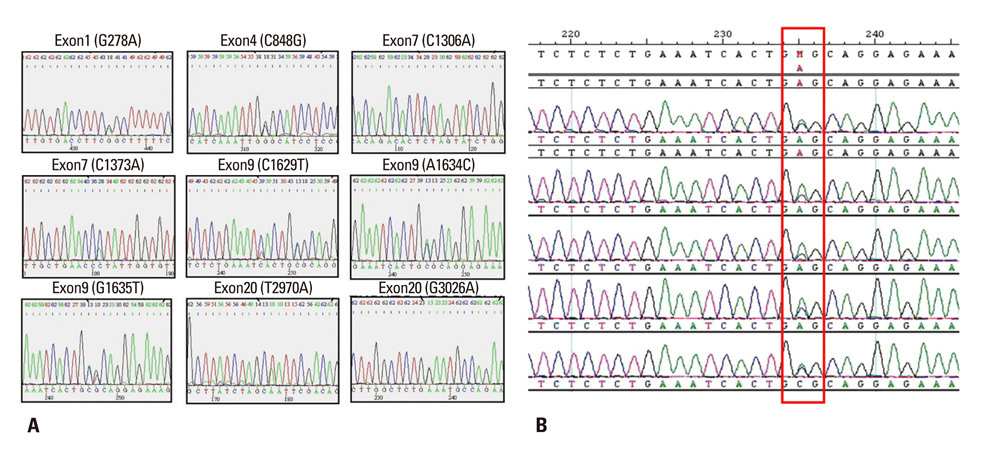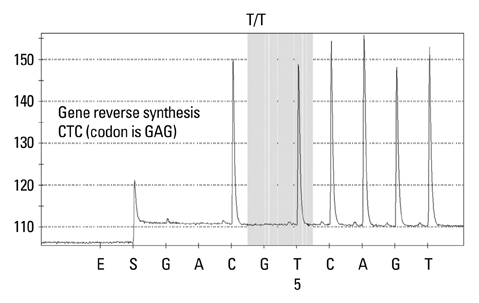Yonsei Med J.
2013 Jul;54(4):883-887. 10.3349/ymj.2013.54.4.883.
PIK3CA Mutations in Hepatocellular Carcinoma in Korea
- Affiliations
-
- 1Department of Clinical Research, Samsung Biomedical Research Institute, Seoul, Korea.
- 2Department of Pathology, Samsung Medical Center, Sungkyunkwan University School of Medicine, Seoul, Korea.
- 3Division of Hematology-Oncology, Department of Medicine, Samsung Medical Center, Sungkyunkwan University School of Medicine, Seoul, Korea. hoylim@skku.edu
- 4Department of Internal Medicine, Yonsei Cancer Center, Cancer Metastasis Research Center, Yonsei University College of Medicine, Seoul, Korea.
- KMID: 2158221
- DOI: http://doi.org/10.3349/ymj.2013.54.4.883
Abstract
- PURPOSE
Phosphatidylinositol 3-kinases/AKT pathway plays a pivotal role in hepatocellular carcinoma (HCC). Mutant PIK3CA, encoding the p110a catalytic subunit, stimulates the AKT pathway and promotes cell growth in various cancers. PIK3CA mutation rate has been usually reported as low frequency (<5%) in HCC except one report from Korea with 35.6%. Therefore, we investigated the frequency of PIK3CA mutations in Korean HCC patients.
MATERIALS AND METHODS
We sequenced exons1, 3, 4, 6, 7, 8, 9, 19 and 20 of PIK3CA in 268 HCC tumor tissue samples by Sanger method and pyrosequencing assay.
RESULTS
In this study, the mutations were not detected in exons3, 6, 8, and 19, and detected 1 at unknown SNP in exon1 and exon4, 2 at unknown SNP in exon7, 2 at unknown SNP in exon20. However, 1 at unknown SNP, 1 at G1635T and surprisingly all samples at A1634Cin exon9 were detected by Sanger method. Additional experiments with normal tissue, cloning experiments and a pyrosequencing assay revealed that the double peak at A1634C of exon9 is a pseudogene, not true mutation. The mutations found in this study were all different and small numbers, therefore, we cannot conclude specific relationship between clinical characteristics of HCC and mutation of PIK3CA.
CONCLUSION
Our study suggests that the rate of PIK3CA mutation in the Korea population is in fact similar to the rates seen elsewhere in the world.
Keyword
MeSH Terms
-
Adolescent
Adult
Aged
Asian Continental Ancestry Group/genetics
Carcinoma, Hepatocellular/*genetics
Exons
Female
Humans
Liver Neoplasms/*genetics
Male
Middle Aged
*Mutation
Mutation Rate
Phosphatidylinositol 3-Kinases/*genetics
Polymorphism, Single Nucleotide
Republic of Korea
Young Adult
Phosphatidylinositol 3-Kinases
Figure
Reference
-
1. GLOBOCAN. 2008 [Internet]. accessed on 2011 June 28. Available at: http://globocan.iarc.fr.2. Korean National Cancer Center [Internet]. accessed on 2011 April 1. Available at: http://www.ncc.re.kr.3. Marra M, Sordelli IM, Lombardi A, Lamberti M, Tarantino L, Giudice A, et al. Molecular targets and oxidative stress biomarkers in hepatocellular carcinoma: an overview. J Transl Med. 2011; 9:171.
Article4. Caraglia M, Giuberti G, Marra M, Addeo R, Montella L, Murolo M, et al. Oxidative stress and ERK1/2 phosphorylation as predictors of outcome in hepatocellular carcinoma patients treated with sorafenib plus octreotide LAR. Cell Death Dis. 2011; 2:e150.
Article5. Prete SD, Montella L, Caraglia M, Maiorino L, Cennamo G, Montesarchio V, et al. Sorafenib plus octreotide is an effective and safe treatment in advanced hepatocellular carcinoma: multicenter phase II So.LAR. study. Cancer Chemother Pharmacol. 2010; 66:837–844.
Article6. Manning BD, Cantley LC. AKT/PKB signaling: navigating downstream. Cell. 2007; 129:1261–1274.
Article7. Mínguez B, Tovar V, Chiang D, Villanueva A, Llovet JM. Pathogenesis of hepatocellular carcinoma and molecular therapies. Curr Opin Gastroenterol. 2009; 25:186–194.
Article8. Cantley LC. The phosphoinositide 3-kinase pathway. Science. 2002; 296:1655–1657.
Article9. Samuels Y, Velculescu VE. Oncogenic mutations of PIK3CA in human cancers. Cell Cycle. 2004; 3:1221–1224.
Article10. Samuels Y, Wang Z, Bardelli A, Silliman N, Ptak J, Szabo S, et al. High frequency of mutations of the PIK3CA gene in human cancers. Science. 2004; 304:554.
Article11. Lai YL, Mau BL, Cheng WH, Chen HM, Chiu HH, Tzen CY. PIK3CA exon 20 mutation is independently associated with a poor prognosis in breast cancer patients. Ann Surg Oncol. 2008; 15:1064–1069.
Article12. Miyaki M, Iijima T, Yamaguchi T, Takahashi K, Matsumoto H, Yasutome M, et al. Mutations of the PIK3CA gene in hereditary colorectal cancers. Int J Cancer. 2007; 121:1627–1630.13. Lee JW, Soung YH, Kim SY, Lee HW, Park WS, Nam SW, et al. PIK3CA gene is frequently mutated in breast carcinomas and hepatocellular carcinomas. Oncogene. 2005; 24:1477–1480.
Article14. Tanaka Y, Kanai F, Tada M, Asaoka Y, Guleng B, Jazag A, et al. Absence of PIK3CA hotspot mutations in hepatocellular carcinoma in Japanese patients. Oncogene. 2006; 25:2950–2952.
Article15. Boyault S, Rickman DS, de Reyniés A, Balabaud C, Rebouissou S, Jeannot E, et al. Transcriptome classification of HCC is related to gene alterations and to new therapeutic targets. Hepatology. 2007; 45:42–52.
Article16. Riener MO, Bawohl M, Clavien PA, Jochum W. Rare PIK3CA hotspot mutations in carcinomas of the biliary tract. Genes Chromosomes Cancer. 2008; 47:363–367.17. Li X, Zhang Q, He W, Meng W, Yan J, Zhang L, et al. Low frequency of PIK3CA gene mutations in hepatocellular carcinoma in Chinese population. Pathol Oncol Res. 2012; 18:57–60.
Article18. Colombino M, Sperlongano P, Izzo F, Tatangelo F, Botti G, Lombardi A, et al. BRAF and PIK3CA genes are somatically mutated in hepatocellular carcinoma among patients from South Italy. Cell Death Dis. 2012; 3:e259.
Article19. McDermid HE, Morrow BE. Genomic disorders on 22q11. Am J Hum Genet. 2002; 70:1077–1088.
Article20. Baker CL, Vaughn CP, Samowitz WS. A PIK3CA pyrosequencing-based assay that excludes pseudogene interference. J Mol Diagn. 2012; 14:56–60.
Article
- Full Text Links
- Actions
-
Cited
- CITED
-
- Close
- Share
- Similar articles
-
- Frequency of PIK3CA mutations in different subsites of head and neck squamous cell carcinoma in southern Thailand
- Concomitant PIK3CA and TP53 Mutations in Breast Cancer: An Analysis of Clinicopathologic and Mutational Features, Neoadjuvant Therapeutic Response, and Prognosis
- Prevalence and Prognostic Role of PIK3CA/AKT1 Mutations in Chinese Breast Cancer Patients
- Mutations of the Pre-S Region in HBV-Associated Liver Cirrhosis and Hepatocellular Carcinoma
- PIK3CA Mutation is Associated with Poor Response to HER2-Targeted Therapy in Breast Cancer Patients



